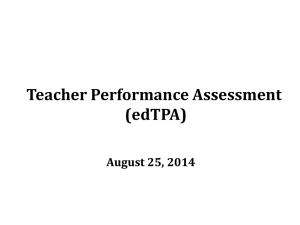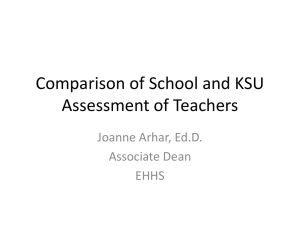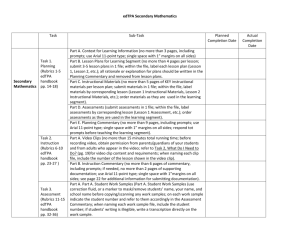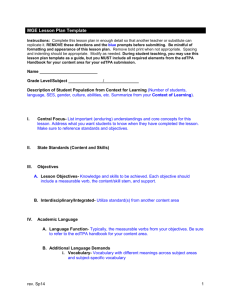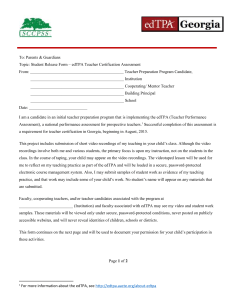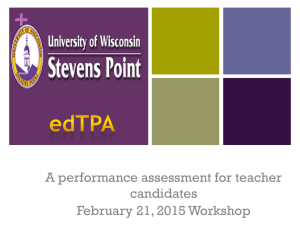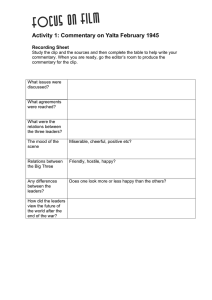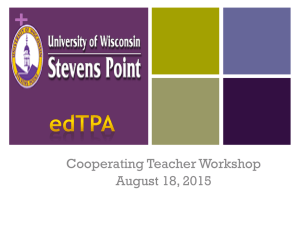+ A Performance Assessment for Teacher Candidates
advertisement
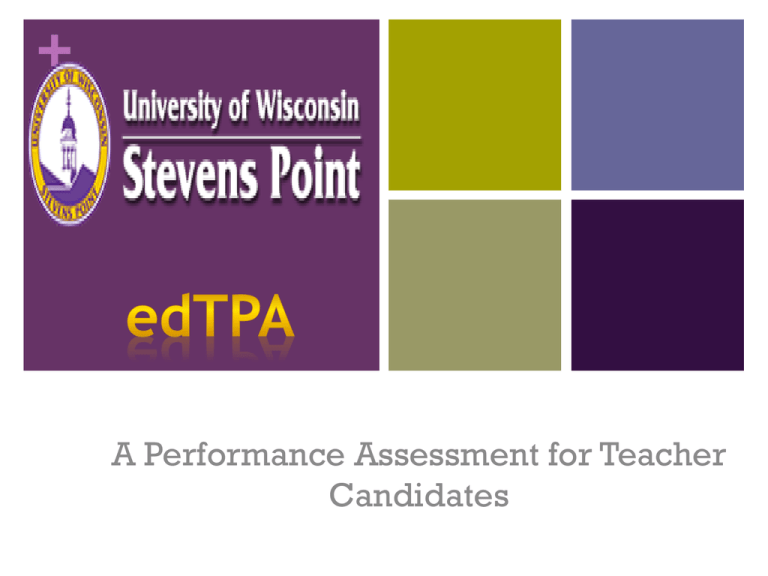
+ A Performance Assessment for Teacher Candidates + Architecture of the edTPA + Task #1: Planning for Instruction & Assessment Artifacts include: Context for Learning, Lesson Plans, Instructional Materials, Assessments, Commentary Planning for Learning Planning to Support Varied Student Learning Needs Using Knowledge of Students to Inform Teaching & Learning Identifying & Supporting Language Demands Planning Assessments to Monitor & Support Student Learning + Task #2: Instructing & Engaging Students in Learning Artifacts Include: Video Clip(s), Commentary Learning Environments Engaging Students in Learning Deepening Student Learning Subject-Specific Pedagogy Analyzing Teaching Effectiveness + Task #3: Assessing Student Learning Artifacts include: Student Work Samples, Evidence of Feedback, Evaluation Criteria Commentary Analysis of Student Learning Providing Feedback to Guide Further Learning Student Use of Feedback Analyzing Students’ Language Use and Literacy Using Assessment to Inform Instruction + Revisiting Task 1 Instructional Materials Take a moment to look at your handbook and Task 1 What does it say about instructional materials? + Task #2: Instructing & Engaging Students in Learning Artifacts Video include: Clip(s) & Commentary Instructional Materials, Transcription of Inaudible Segments + Let’s take a look In groups of two or three take some time now to look through your edTPA Handbook section for Task 2. Task #2: Instructing & Engaging Students in Learning Notice the guidelines for your clips and for writing the commentary. Are additional pages allowed for instructional materials? + What do you notice? Video Clip – how many clips and how many minutes? Commentary how many pages? Are additional pages allowed for instructional materials? Questions? Wonderings? Discoveries? + Task 2: Instruction Now take a look at your rubrics 6-10. + Overview of edTPA Video Recording 1. Classroom video reminders Video Permissions Students without permission? Confidentiality of video 2. Video requirements Continuous and unedited No stops, no pauses Captions and subtitles Avoid high definition Audio quality is your priority + Overview of Video Recording Pearson’s video specifications File size maximum? 200 MB File types? Are additional videos allowed for evidence of student language use, assessment and/or feedback? flv, asf, qt, mov, mpg, mpeg, avi, wmv, mp4, m4v Review the Artifacts and Commentary Specifications Chart for each task Integrate your video as part of the Task 2 Commentary Use Time Stamps to refer to locations in your video as evidence for for inaudible transcripts + Video Recording Equipment 1. Digital video camera 2. Tripod/Swivl Device 3. Other recording devices 4. Device mounts 5. Audio devices We have some of these and you can sign them out to use them. + Chalk & Wire UWSP chosen platform for edTPA templates and submission process Course You Fees will cover this expense. will receive your Chalk and Wire Account at our first edTPA meeting in the fall. + Task #3: Assessing Student Learning – a closer look Student Work Evidence of Feedback Evaluation Samples Criteria Commentary + Let’s take a look In groups of two or three take some time now to look through your edTPA Handbook section for Task 3. Task #3: Assessing Student Learning + First – what do you need to do? Look for specifics re: what is to be evaluated Pay attention to expectations for evaluation criteria (rubric/answer key) specific student work samples your feedback to students targeted academic language function Questions? Wonderings? Discoveries? + Second – what do you need to write? Notice expectations for Identifying objectives and standards Providing overview of class performance Evidence re: 3 student work samples Feedback to support explanations Extent to which students were able to use the language to develop understanding Using formative assessment to inform student learning + Rubrics- edTPA Task 3 In groups of two or three take some time now to look through your rubrics 11-15 in your edTPA Handbook section for Task 3. Pay attention to connections across all three Tasks. + What can you be doing between now and next semester? Task 1 Practice using the lesson plan framework in your methods classes Consider your rationale and supporting research/theory for decisions that you are making (commentary) Work with your application of the gradual release model in designing your plan + What can you be doing between now and next semester? Task 2 Pay attention in your practicum experiences. See what you are learning about how your lessons are going, about student learning, about feedback that you are giving. Practice recording with your equipment! + What can you be doing between now and next semester? Task 3 In your methods and practicum experiences: Pay attention to assessment and feedback dimensions of learning. Particularly notice and work with feedback that is constructive and helps the student move to their next step in learning. + Helpful Resources for you: Choice Words and Opening Minds by Peter Johnston (about engaged student learning and feedback) Mindset by Carol Dweck (about dynamic learning) Interactive Strategies for Content Learning by Doug Buehl (any additional ideas/strategies resources) Gradual Release of Responsibility article by Fisher posted on the School of Education edTPA webpage How to Create a Culture of Achievement by Doug Fisher, Nancy Frey and Ian Pumpian School of Education edTPA webpage http://www.uwsp.edu/education/Pages/edtpa.aspx


